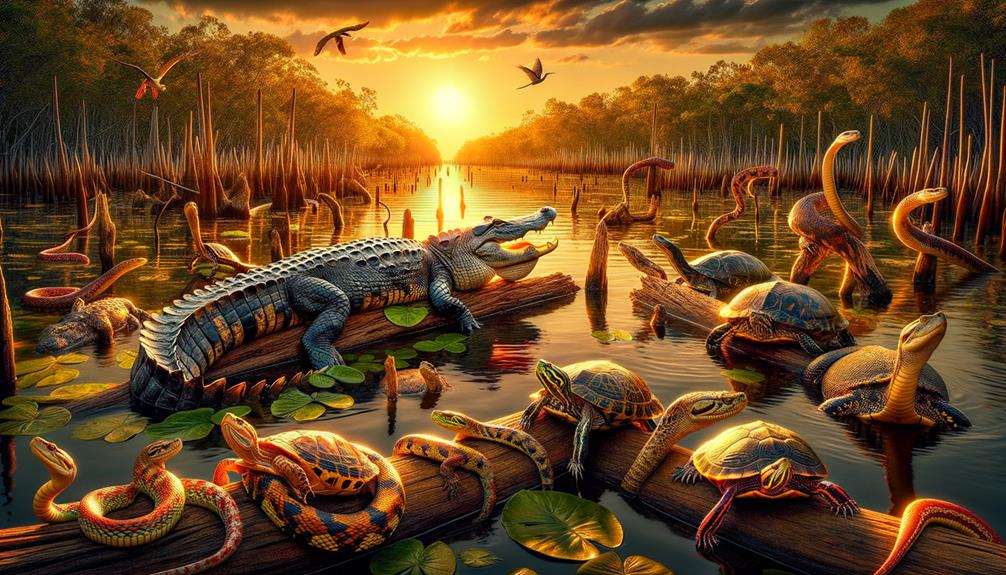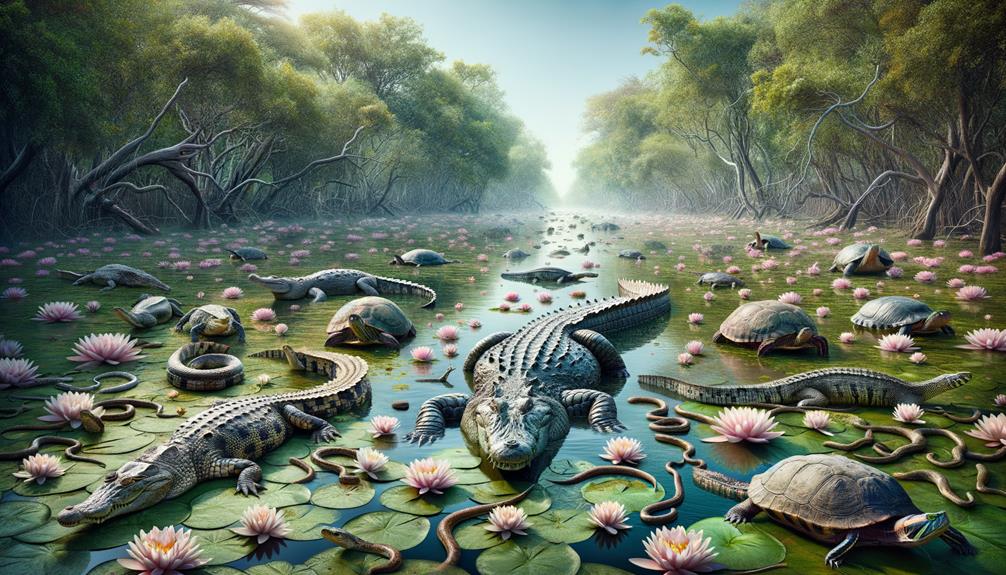Exploring the Nile River’s ancient reptiles, I stumbled upon a fascinating array of creatures that inspired both awe and fear. The iconic Nile cobra, revered as a symbol of pharaohs’ power, left an indelible mark on history. The legendary tale of Cleopatra’s fatal encounter with a venomous asp continues to captivate people to this day. Deadly vipers, equipped with heat-sensing pits, thrived in the harsh desert environment. The towering and terrifying Nile crocodiles exemplified the river’s raw power, while monitor lizards, agile swimmers and skilled hunters, roamed the area with ease. Meanwhile, Nile softshell turtles played a vital role in maintaining the ecosystem’s delicate balance. Each reptile’s unique adaptations and interactions painted a vivid picture of survival and dominance in the ancient Nile. For a deeper dive into the intriguing world of these ancient creatures, read on.
Key Takeaways
Egyptian cobras held significant symbolic meaning in ancient Egyptian culture, representing pharaohs’ divine power and protection. They were often depicted on crowns and in burial practices.
As apex predators in the Nile River, Nile crocodiles play a crucial role in maintaining ecological balance. However, their populations are threatened by human activities.
Desert vipers, such as the Saharan horned viper and white-lipped viper, have adapted to the harsh arid environments of the desert. Unfortunately, they face habitat loss and other environmental challenges.
Nile monitor lizards are versatile predators that thrive along the Nile River. Despite their adaptability, they are threatened by habitat destruction and invasive species.
Nile softshell turtles are vital components of the Nile ecosystem. Unfortunately, they are vulnerable to pollution, overfishing, and habitat degradation, which can have devastating consequences for the ecosystem.
Iconic Nile Cobras
In ancient Egyptian culture, the Egyptian cobra, or asp, was more than just a venomous snake – it was a revered symbol of the pharaoh’s power and protection. Native to the Nile region, these iconic reptiles held immense significance for ancient Egyptians. The cobra, depicted as the divine uraeus, often reared on the pharaoh’s crown, symbolizing the monarch’s divine right to rule and their authority over life and death.
The Nile River, a lifeline for Egypt’s civilization, was home to these formidable creatures. Ancient Egyptians respected and feared the Egyptian cobra, understanding its lethal potential. Cleopatra, the last Ptolemaic ruler of Egypt, famously chose the cobra’s bite as her method of death, sealing her fate with an emblem of her own sovereignty.
These venomous snakes were so venerated that they were mummified and buried alongside pharaohs, serving as sacred guardians in the afterlife. Their role in religion and mythology highlights the deep connection between the Nile’s natural world and ancient Egyptian spirituality. The cobra’s presence in these ancient narratives reflects a complex mix of emotions, from reverence to fear, that continues to fascinate us today.
Venomous Asps
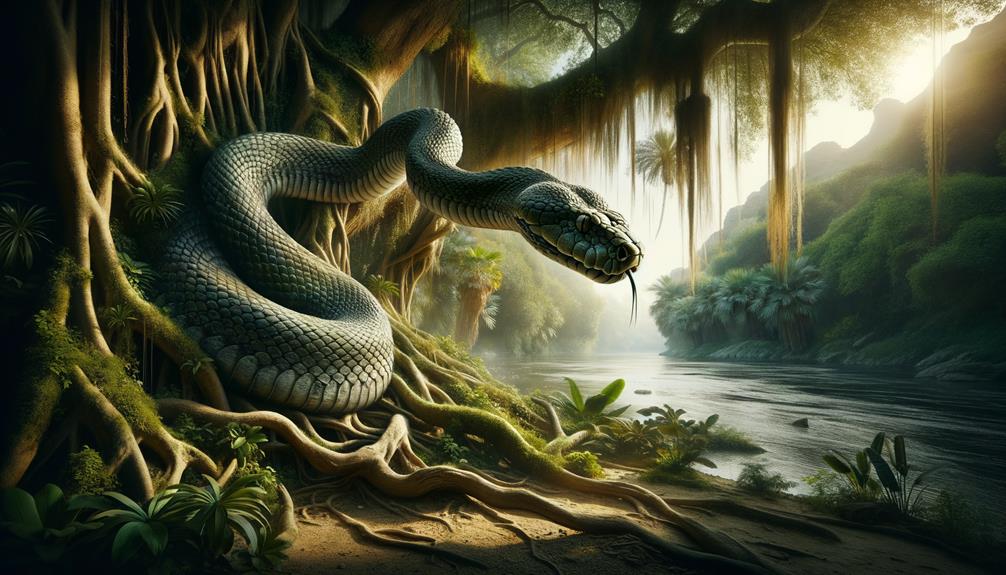
Cobras, particularly the venomous Egyptian asp, were feared predators in ancient Egypt, symbolizing the pharaohs’ divine authority and ancient rituals. The Egyptian cobra, native to the Nile Delta, carried a potent neurotoxin capable of causing paralysis and eventual asphyxiation. This deadly venom made the snake both respected and feared, resonating deeply with Egyptian culture.
Pharaohs used the image of the Egyptian cobra on their headdresses and crowns, symbolizing their supreme power and divine protection. The asp’s lethal bite was not only a tool of execution for those defying royal edicts but also represented the ruler’s ability to wield life and death. Cleopatra, the last active ruler of the Ptolemaic Kingdom of Egypt, infamously chose the venomous asp to end her own life, further solidifying its place in history.
Living in the fertile Nile Delta, these cobras were a constant presence, their threat a reminder of nature’s unforgiving power. The reverence and fear they inspired underscored the pharaohs’ connection to the divine, intertwining natural danger with the sovereignty of ancient Egypt’s rulers.
Deadly Desert Vipers
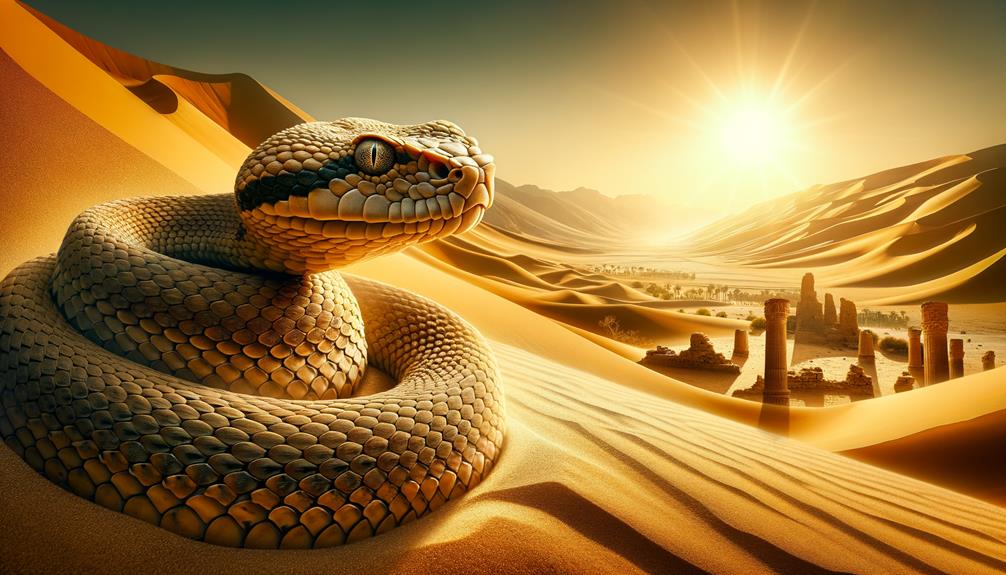
When I think about the deadly desert vipers that inhabit the Nile region, I’m struck by their incredible adaptations to the harsh, arid environment. These venomous predators, including the Egyptian cobra and black mamba, use their potent venom for both hunting and self-defense. While their survival strategies are remarkable, they face significant threats from habitat loss due to human encroachment.
Habitat and Adaptations
Thriving in the harsh, sun-baked expanses near the Nile, deadly desert vipers like the Saharan horned viper and the white-lipped viper have developed remarkable adaptations that enable them to detect and ambush prey with lethal precision. These formidable predators inhabit the arid regions surrounding the Nile River basin, coexisting with iconic fauna such as the Nile crocodile, Varanus niloticus, and Hippopotamus amphibius.
The Saharan horned viper, with its distinctive horns above its eyes, blends seamlessly into the rocky, sandy terrain, providing perfect camouflage. This adaptation not only helps it hide from predators but also ambush prey. The white-lipped viper, recognizable by its striking white-edged mouth, is equally adept at surviving the extreme conditions. Both species possess heat-sensing pits on their faces, allowing them to detect the body heat of warm-blooded prey even in the dark, a vital adaptation for nocturnal hunting in the desert’s cool nights.
These vipers’ ambush strategy is simple yet effective: they lie in wait, perfectly still, until an unsuspecting small mammal, bird, or reptile ventures too close. In this unforgiving environment, every adaptation counts, making these vipers marvels of evolutionary engineering.
Venom and Hunting Techniques
Among the deadliest creatures inhabiting the Nile’s arid regions, desert vipers have honed a lethal combination of potent venom and sophisticated hunting techniques to dominate their ecosystem. The saw-scaled viper, notorious for causing the most snake-bite fatalities in parts of Africa, employs a specialized delivery system to inject its venom, leaving its prey with little chance of survival.
The desert horned viper’s unique heat-sensing pit allows it to detect warm-blooded prey with precision. Its lightning-fast strike leaves victims no time to react. The Egyptian cobra, once revered in ancient Egypt, wields a neurotoxin that causes paralysis and potential death without prompt medical aid.
Meanwhile, the banded Egyptian sand viper relies on its cryptic coloration and burrowing abilities to ambush its prey. Its strike penetrates deep, ensuring a lethal grip. The Saharan horned viper’s distinctive eye horns deliver hemotoxic venom that destroys red blood cells, leading to severe bleeding.
In this intricate ecosystem, where Nile monitors feed and the Nile crocodile is one of the dominant predators, these vipers play a vital role within the Nile River system.
Survival Strategies and Threats
Desert vipers in the Nile region have developed remarkable survival strategies to thrive in the harsh, arid environment and counter the numerous threats they face. The Saharan horned viper, for example, relies on its exceptional camouflage and heat-sensing pits to ambush prey like the swift monitor lizard. Its hemotoxic venom incapacitates victims quickly, ensuring a swift kill in a landscape where every second counts.
These vipers face significant predators, such as Nile crocodiles and Nile perch, which share their habitat, and they must continually evade these dangers. Invasive species also pose a challenge, disrupting the ecological balance and competing with native vipers for food and shelter.
The saw-scaled viper, notorious for causing the most human fatalities, has adapted by becoming highly aggressive and fast-striking. This makes it a formidable adversary in the wild and increases its encounters with humans.
Despite these threats, desert vipers continue to thrive through a combination of stealth, lethal efficiency, and adaptability. Their survival is a testament to nature’s ingenuity and resilience, demonstrating an impressive ability to adapt and endure in the face of adversity.
Crocodilian Predators
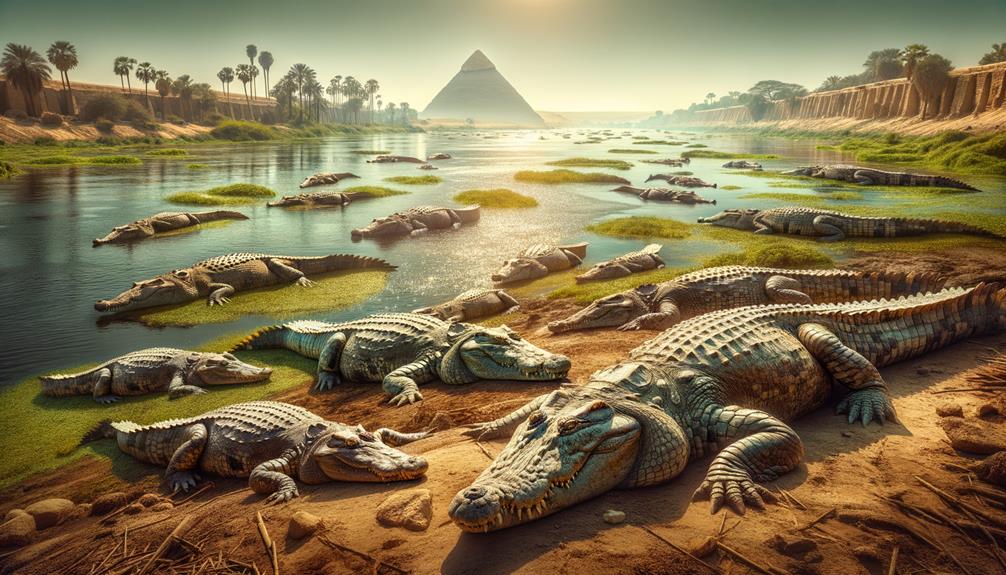
Nile crocodiles are the largest and most fearsome reptiles on Earth, dominating the Nile River ecosystem as apex predators. These formidable creatures, scientifically known as Crocodylus niloticus, can grow up to 6 meters in length and weigh over 1,000 kilograms. Their muscular bodies and powerful jaws make them exceptional hunters, capable of taking down a variety of prey including fish, birds, and mammals, and even other smaller crocodiles.
Found throughout much of eastern and central Africa, Nile crocodiles patrol the entire length of the Nile River from Egypt to Mozambique. As apex predators, they play a central role in maintaining the balance of the river’s ecosystem. By controlling the population of various species, they ensure the health and sustainability of the aquatic food chain.
Unfortunately, Nile crocodile populations face significant threats. Habitat loss, hunting, and human-wildlife conflict have led to a decline in their numbers, resulting in their classification as Vulnerable on the IUCN Red List. Preserving these ancient reptiles is vital for maintaining the ecological integrity of the Nile River and its surrounding environments.
Monitor Lizards
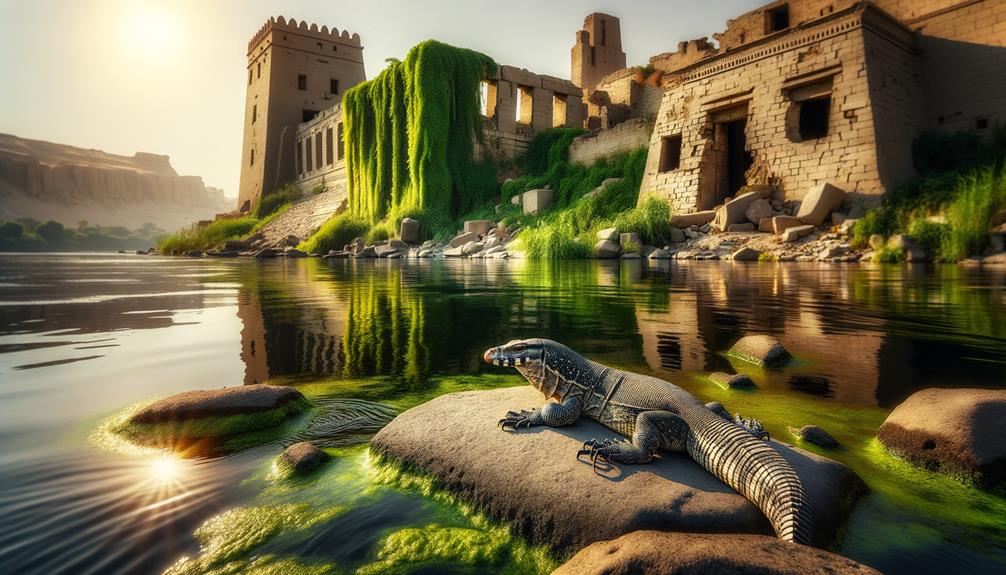
The Nile monitor, Africa’s longest lizard, thrives in diverse habitats along the Nile River and has even established populations in Florida. These lizards are known for their physical strength and exhibit fascinating behaviors and varied diets that impact both native and non-native ecosystems. However, they face significant conservation challenges due to habitat loss and their controversial presence in the pet trade, which raises concerns about their adaptability and survival.
Habitat and Distribution
Varanus niloticus, commonly known as the Nile monitor, flourishes in diverse habitats near rivers, lakes, and wetlands across sub-Saharan Africa. This remarkable adaptability to both aquatic and terrestrial environments allows them to thrive in various settings. Found throughout much of the continent, they’re particularly abundant along the Nile River. As one of Africa’s largest lizards, Nile monitors can reach up to 2.4 meters (8 feet) in length. Their strong limbs and powerful tails make them excellent swimmers, enabling them to navigate the waters of the Nile with ease.
Nile monitors are adept at more than just swimming; they’re also skilled climbers and runners. This versatility allows them to exploit a range of habitats. From the lush riverbanks of the Nile to the expansive wetlands scattered across sub-Saharan Africa, these lizards have carved out a niche for themselves in both aquatic and terrestrial domains. However, they’re not found in desert environments, as their need for water sources limits their distribution. Interestingly, established breeding populations have even been reported in regions of Florida, USA, likely originating from escaped or released pets. This highlights their remarkable adaptability, even beyond their native range.
Behavior and Diet
In the realm of behavior and diet, Nile monitors showcase remarkable adaptability as they navigate their environments with a blend of swimming prowess, climbing agility, and terrestrial speed. Found across a wide range of African habitats, these reptiles use their powerful limbs and tails to excel in both aquatic and terrestrial settings.
As opportunistic predators, Nile monitors maintain a varied diet, feeding on fish, birds, small mammals, and even the eggs and hatchlings of crocodiles. Their strong jaws and sharp teeth enable them to capture and consume prey much larger than themselves, highlighting their formidable hunting capabilities. During the day, they bask in the sun to regulate their body temperature, a critical behavior for their survival. As night falls, their nocturnal activities intensify, driven by their relentless quest for food.
When threatened, Nile monitors become aggressive, using their powerful tails, claws, and jaws to fend off potential predators or human intruders. This adaptability and defensive prowess highlight the Nile monitor’s remarkable survival strategies.
Conservation and Threats
Facing numerous conservation challenges, Nile monitors struggle to survive in their native sub-Saharan Africa, where habitat destruction and human conflict threaten their existence. The expansion of urban areas and agriculture leads to the destruction of their natural habitats, causing them to venture into human settlements, resulting in direct persecution.
Invasive Nile monitor populations have also become a significant issue, particularly in South Florida, where they compete with native species like the American alligator and American crocodile for resources. To address this issue, authorities have implemented measures such as:
- Regulation: Nile monitors are classified as a Class III species in Florida, requiring permits for possession.
- Management Programs: Ongoing efforts focus on tracking and controlling the spread of these invasive reptiles.
- Public Awareness: Educational campaigns inform the public about the risks posed by invasive Nile monitors to the local ecosystem.
Despite their aggressive nature and unsuitability as pets, Nile monitors continue to be traded in the pet industry. Furthermore, genetic studies have revealed that the Nile monitor is a species complex, comprising distinct species such as the ornate monitor and West African Nile monitor. Understanding these differences is crucial for developing effective conservation strategies.
Softshell Turtles

The Nile softshell turtle‘s remarkable adaptations for life in the water are on full display. Its flat, hydrodynamic shell and webbed feet make it a natural swimmer, agile and at ease in the Nile River basin. Scientifically known as Trionyx triunguis, these turtles thrive alongside other freshwater inhabitants like the Nile perch and monitor lizards.
In the complex ecosystem of the Nile, the Nile softshell turtle plays a vital role. As both predator and prey, it helps balance the food web. It feeds on small fish, insects, and aquatic plants, while also falling prey to larger predators. This delicate balance highlights the need to maintain healthy populations for the sake of the aquatic environment.
However, the Nile softshell turtle’s sensitivity to its environment makes it vulnerable to changes and habitat degradation. Pollution, overfishing, and human activities pose significant threats. To protect these ancient reptiles, conservation efforts are crucial. By reducing pollution and regulating fishing practices, we can help safeguard the Nile softshell turtle’s survival and preserve the biodiversity of the Nile River basin.
Frequently Asked Questions
What Animals Lived Near the Nile River in Ancient Egypt?
Ancient Egypt’s Nile River was home to a diverse array of creatures. The Nile crocodile, Egyptian cobra, and Nile monitor lizard were just a few of the many species that inhabited the region. The river also supported a variety of aquatic life, including Nile soft-shelled turtles and massive Nile perch fish, which played a vital role in the ecosystem.
Were There Crocodiles in the Nile River?
The Nile River was a haven for crocodiles, with the massive Nile crocodile being a dominant presence. These fearsome reptiles, which could grow up to 6 meters in length, played a vital role in the river’s ecosystem and held significant cultural importance in ancient Egyptian society.
What Animals Swim in the Nile River?
When I venture into the Nile River, I’m struck by the diverse array of creatures calling its waters home. I spot Nile crocodiles, softshell turtles, and monitor lizards, as well as venomous snakes like the Egyptian cobra. The sheer variety of species thriving in this ecosystem is a testament to its vibrancy.
Were There Crocodiles in Ancient Egypt?
Ancient Egypt was indeed home to crocodiles. Genetic research confirms that Egyptians interacted with two species: the Nile crocodile and the smaller, less aggressive Crocodylus suchus. The Egyptians had a special affinity for the latter, going so far as to mummify them and keep them as temple pets.


